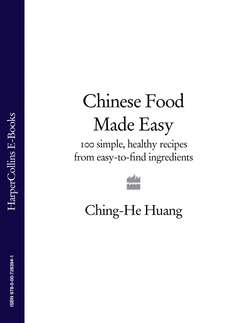Читать книгу Chinese Food Made Easy: 100 simple, healthy recipes from easy-to-find ingredients - Ching-He Huang - Страница 27
Dan Dan noodles
ОглавлениеSERVES 4
FOR THE MEAT TOPPING
2 tablespoons groundnut oil
2 garlic cloves, crushed and finely chopped
1 tablespoon freshly grated root ginger
1 medium red chilli, deseeded and finely chopped
250g/9oz minced beef
1 tablespoon Shaohsing rice wine or dry sherry
100g/31/2oz cornichons or cocktail gherkins in vinegar, drained and finely diced
1 tablespoon light soy sauce
FOR THE NOODLE BASE AND SAUCE
500g/1lb 2oz any wheat flour noodles
toasted sesame oil
1 tablespoon sesame paste, or tahini blended with 1 teaspoon toasted sesame oil
1 tablespoon chilli oil
1 tablespoon Chinkiang black rice vinegar or balsamic vinegar
750ml/11/4 pints chicken stock
FOR THE GARNISH
1 teaspoon whole Sichuan peppercorns
1 large spring onion, finely chopped
1 small handful of fresh coriander, leaves and stalks, finely chopped
1 teaspoon chilli oil
1 teaspoon toasted sesame oil
For the method, please see overleaf.
1 Cook the noodles according to the packet instructions, drain and toss them through with some sesame oil. Put to one side.
2 To make the meat topping, heat a wok over a high heat and add the groundnut oil. Add the garlic, ginger and chilli and stir-fry for a few seconds, then add the minced beef. As the beef starts to turn brown, add the rice wine or sherry and cook for a few seconds. Stir in the cornichons or gherkins and cook until fragrant, then season with the soy sauce and keep on a very low heat.
3 Next, make the noodle sauce. Put the sesame paste or blended tahini, the chilli oil and vinegar into a small wok or pan, add the stock and bring to the boil. Reduce the heat to low.
4 Put the Sichuan peppercorns for the garnish into a small pan and dry roast until fragrant, then remove from the heat and crush in a pestle and mortar, or place in a plastic bag and bash with a rolling pin.
5 To serve, either divide the noodles between four bowls or leave in the wok, then ladle on the sauce and top with the stir-fry. Garnish with the Sichuan peppercorns, spring onion and coriander. Drizzle chilli oil over the dish, add a drizzle of sesame oil to taste around the edge of the sauce and serve immediately, with extra chilli oil, if you like.
This is one of Sichuan’s most famous dishes and is also served in Chinese restaurants throughout the world. Apparently, it was named after Old Mrs. Chen, who served this in her restaurant. In Sichuan they use Suan miao, thin Chinese leeks, but most cooks substitute spring onions.
The word ‘Ma-po’ describes Old Mrs. Chen’s ‘pockmarked complexion’. The Chinese are not known for being very tactful – my grandmother used to refer to a South African friend of mine as ‘the one with the “sharp” nose’ – she didn’t mean it impolitely; to the Chinese, pointed noses are deemed more beautiful. Needless to say, I had some explaining to do to my friend.
